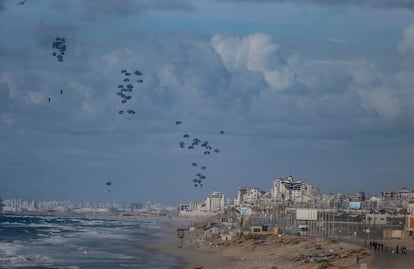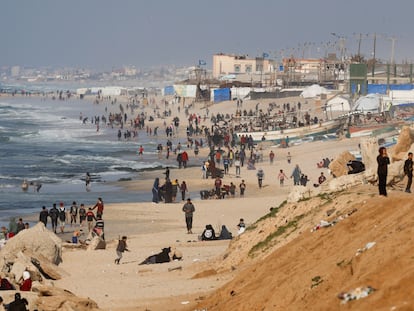US plans to build temporary port in Gaza for humanitarian aid
The temporary dock will be able to unload the equivalent of ‘hundreds of additional truckloads of aid per day’ according to senior officials

The United States is planning an “emergency” military mission in cooperation with other allies to establish a temporary port on the Mediterranean coast of Gaza for the entry of humanitarian aid by sea, according to senior government officials, who said Thursday that Washington has worked “very closely” with Israel in the development of the initiative. The formal announcement came during President Joe Biden’s State of the Union address to both houses of Congress. Israel “fully supports” the U.S. initiative, according to a senior official quoted by Reuters.
The port will be able to accommodate “large ships with cargoes of water, food, and medicine” and structures to provide shelter for Gazans displaced by the war. The main facility will be a temporary dock that will unload the equivalent of “hundreds of additional truckloads of aid per day.” Initially, the shipments will come from the port of Larnaca on the island of Cyprus, the European Union country closest to Gaza at around 210 nautical miles (about 380 kilometers).
The senior officials, who spoke on condition of anonymity, did not provide details on how the port’s pier will be constructed. They did say that U.S. soldiers will not need to be deployed on Gazan soil, in keeping with one of Biden’s strongest pledges since the conflict began. It will consist of structures built over the sea. One of the senior officials clarified that the U.S. has “unique capabilities” that allow it to erect this type of platform. The planning and execution of the project will require “several weeks,” — between 45 and 60 days approximately. In past conflicts in which U.S. forces have needed to build a bridgehead, they have erected such a structure further out to sea, from their ships, and then brought it close to shore.
Official Israeli sources quoted by the public television channel Kan confirmed that the measure had been coordinated with the country’s authorities, but also admitted that it was partly due to Washington’s dissatisfaction with the amount of humanitarian aid entering Gaza and mistrust of Israel’s willingness to allow for increased flows. Senior officials in Washington have pointed out that they have been working with Israel for months “to establish this mechanism.”
The challenges are huge. Not only is there the logistical problems of building the port itself and getting the aid in. There is also the question of how to distribute it in a narrow strip of land where transport is complicated and the needs of the population are extreme. The European Commissioner for Crisis Management and Humanitarian Aid, Janez Lenarcic, admitted Wednesday at a press conference in Jerusalem that, in addition to a port in Gaza, a structure would be needed to ensure the orderly reception and distribution of aid on arrival. “The scenes that we have seen, of crowds of hungry people running towards the parachutes coming ashore, is not the right way to handle, receive and distribute it,” he said.
Biden made the announcement a day after the EU said it is considering setting up a maritime humanitarian corridor to bring aid to Gaza, where some 500,000 people are on the brink of starvation and malnutrition rates among children have risen to almost 16% since the war broke out, according to the UN World Health Organization, which denounced Tuesday that the deteriorating nutritional status of the Strip’s population after five months of war “is unprecedented globally.”
The maritime option is the only means left in the face of the problems affecting land and air delivery. Israeli obstacles, the lack of means of distribution and the chaos prevailing around convoys have reduced deliveries by road to half of what they were in December and January, when they were already insufficient to tackle the humanitarian crisis. Both hungry citizens and black marketeers are raiding convoys. Israeli ultranationalist groups are also trying to prevent aid from entering, in a stance approved by the majority of the population, who believe that it benefits Hamas or should be used to force the hostages to be handed over, according to polls. Airdrops — as several countries, such as Jordan, Egypt, the United Arab Emirates, France, and the United States have been carrying out in recent weeks — are a meager stopgap solution as the quantities parachuted in are small.
The President of the European Commission, Ursula von der Leyen, will travel to Cyprus Friday to study the maritime project, which has gained momentum following the deaths of more than 100 Gazans last week — some of whom were shot by Israeli soldiers — when they chased an aid convoy. The images of the wounded, the desperation and the bloodstained food have heightened international concern about the humanitarian crisis, caused mainly by Israel’s decision to use famine as a weapon of war.
The U.S. maintains that it continues to press Israel to increase the inflow of aid by land. “The president has instructed that we look at all options and not wait for the Israelis. We are looking for every possible channel to send assistance to Gaza. We will do it by air, by sea, by land, however we can, to get as much aid in as possible,” one of the sources said.
Senior officials have indicated that Israel is preparing to open a new access point, directly to the north of Gaza (the most malnourished area), which will allow “aid to flow directly to the people in the north who are in desperate need of assistance. It was at our request,” they note. Commissioner Lenarcic reported that he had detected “openness” in his Israeli interlocutors to the idea of providing a new access route for aid.
The new port would form a key piece of the Gaza scenario that the United States is preparing with Qatar and Egypt for temporary ceasefire of at least six weeks between Israel and Hamas. A fresh truce would allow for increased and improved distribution of humanitarian assistance, and even the return to the north of displaced Gazans, despite most of their homes having been damaged or destroyed, as Hamas indicated during negotiations in Cairo that reached an impasse Thursday and will not resume until Sunday. “Everything we are doing, including this new mission, is important to establish the conditions in Gaza so that people can eventually return to their places of residence,” said one of the U.S. representatives.
Israeli Prime Minister Benjamin Netanyahu reiterated Thursday that whether or not the truce goes ahead, the army will invade Rafah, where over a million displaced Palestinians are concentrated. “The IDF will continue to operate against all of Hamas’s battalions throughout the Strip — and this includes Rafah, Hamas’s last stronghold. Whoever tells us not to operate in Rafah, is telling us to lose the war — and that will not happen,” he said at a military graduation ceremony.
Sign up for our weekly newsletter to get more English-language news coverage from EL PAÍS USA Edition
Tu suscripción se está usando en otro dispositivo
¿Quieres añadir otro usuario a tu suscripción?
Si continúas leyendo en este dispositivo, no se podrá leer en el otro.
FlechaTu suscripción se está usando en otro dispositivo y solo puedes acceder a EL PAÍS desde un dispositivo a la vez.
Si quieres compartir tu cuenta, cambia tu suscripción a la modalidad Premium, así podrás añadir otro usuario. Cada uno accederá con su propia cuenta de email, lo que os permitirá personalizar vuestra experiencia en EL PAÍS.
¿Tienes una suscripción de empresa? Accede aquí para contratar más cuentas.
En el caso de no saber quién está usando tu cuenta, te recomendamos cambiar tu contraseña aquí.
Si decides continuar compartiendo tu cuenta, este mensaje se mostrará en tu dispositivo y en el de la otra persona que está usando tu cuenta de forma indefinida, afectando a tu experiencia de lectura. Puedes consultar aquí los términos y condiciones de la suscripción digital.
More information
Archived In
Últimas noticias
Alain Aspect, Nobel laureate in physics: ‘Einstein was so smart that he would have had to recognize quantum entanglement’
Imelda Castro, the woman who wants to rule the cartel battleground of Sinaloa
The new victims of the Republican war on Obamacare: Millions hit by soaring health insurance premiums
A country divided on migrant rights: Some US states expand protections while others restrict them
Most viewed
- David King, chemist: ‘There are scientists studying how to cool the planet; nobody should stop these experiments from happening’
- Reinhard Genzel, Nobel laureate in physics: ‘One-minute videos will never give you the truth’
- Oona Chaplin: ‘I told James Cameron that I was living in a treehouse and starting a permaculture project with a friend’
- Sinaloa Cartel war is taking its toll on Los Chapitos
- Mexico completes its trade shift with the entry into force of tariffs on China and countries without trade agreements










































